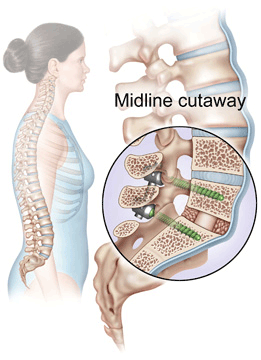Bone Grafts
Introduction
A basic part of any spinal fusion is the bone graft. Bone grafting is used for many types of orthopedic procedures that require bones to heal. Bone grafting is used in two main ways during orthopedic procedures:
- to stimulate the bone to heal
- to provide support to the skeleton by filling gaps between two bones

Stimulate Healing
The most common use of bone graft is to stimulate the healing of bone. The bone graft is used like "fertilizer" to stimulate and speed the bone healing process. Bone tissue that is crushed into powder and placed around a fracture or a fusion site has chemicals in it that stimulate the nearby bones to heal. If the bone is taken from the person's own body, there may also be osteocytes (living bone cells) that survive being transferred to the new location and continue to do their work of making new bone. Even bone taken from someone else will stimulate bone to heal. But bone taken from the same person may be better because the chances are higher that it will have remaining live bone cells after the transfer.
Provide Support
Bone graft is also used for structure. Rather than crush the bone into fine pieces, larger pieces of bone are used to fill a gap between two bones. For example, if the surgeon removes a vertebra or disc, he may place a chunk of bone graft into the space. Because bone is rigid, it will hold the bones apart while the body grows to the ends of the graft. Over time the entire piece of bone that was grafted will be "remodeled" and replaced by the body with new bone. The time it takes to fuse depends on the size of the piece of bone that was used. It is sometimes a slow process that may take several years.
Autograft vs. Allograft
Your surgeon will try to promote and speed the healing of your spinal fusion in a number of ways. The most common approach is to use your own bone whenever possible. Bone taken from your own body is called autograft. Bone graft taken from someone else is called allograft. The surgeon may mix allograft with autograft.
Allograft can come from many types of bones in many different forms. Allograft is usually removed from organ donors and placed in bone banks. Bone banks make sure the bone graft is sterile by testing it for diseases such as hepatitis and AIDS-just like testing done in a blood bank. Because it is not taken from the patient, it does not contain any living cells, and therefore has fewer chemicals to stimulate growth of new bone. The disadvantage of an allograft is that it may not always grow as well or as quickly as an autograft, but a bone-growing protein can be added to the area to make up for what the bone graft lacks. The advantage to using allograft is that the patient does not have to donate the bone graft. This makes the surgery shorter, and there may be less pain afterward. The allograft carries a very small risk of transferring infectious diseases even though it is rigidly tested.
Allograft is very useful when the operation requires more bone graft than your own body can supply. Some major spine fusions need a lot of bone graft. Some surgeries need large pieces of structural bone graft, which may cause problems in the area of the body where the bone was removed.
New Technology
Much research is in progress to design bone graft substitutes, chemicals, and devices that stimulate the bones to fuse. It is well known that electrical current stimulates bone to grow. Many surgeons use electrical stimulation devices during the first weeks of surgery to speed up a fusion. Some artificial bone graft materials have been developed. For instance, sea coral, harvested from oceans, is sometimes used very successfully as the basis for a structural bone replacement. Other developments include
- Demineralized bone matrix (DBM), which is a type of allograft developed from cadaver bones in a bone bank. The bone has the calcium removed and can be turned into a putty, sheet, or gel. The material can then be added to a graft site to improve the fusion.
- Autologous growth factor (AGF), which is a solution used to stimulate bone growth. It is developed in a laboratory from blood platelets (the clotting part of blood). The mixture is usually used in combination with some form of structural support, such as autograft or fusion cages.
- Bone morphogenic protein (BMP), which is a chemical added to bone graft to enhance bone growth when added to a fusion site.
